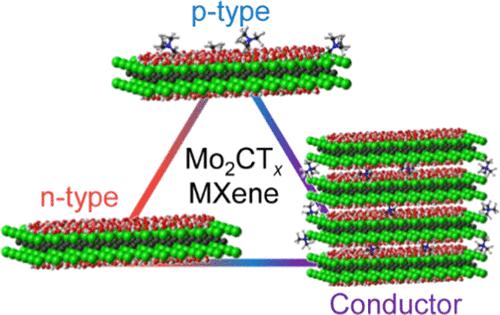Our official English website, www.x-mol.net, welcomes your
feedback! (Note: you will need to create a separate account there.)
N–p-Conductor Transition of Gas Sensing Behaviors in Mo2CTx MXene
ACS Sensors ( IF 8.2 ) Pub Date : 2022-07-15 , DOI: 10.1021/acssensors.2c00658 Junghoon Choi 1 , Benjamin Chacon 2 , Hyunsoo Park 1 , Kanit Hantanasirisakul 2 , Taewoo Kim 1 , Kateryna Shevchuk 2 , Juyun Lee 3, 4 , Hohyung Kang 1 , Soo-Yeon Cho 5 , Jihan Kim 1 , Yury Gogotsi 2 , Seon Joon Kim 6, 7 , Hee-Tae Jung 1
ACS Sensors ( IF 8.2 ) Pub Date : 2022-07-15 , DOI: 10.1021/acssensors.2c00658 Junghoon Choi 1 , Benjamin Chacon 2 , Hyunsoo Park 1 , Kanit Hantanasirisakul 2 , Taewoo Kim 1 , Kateryna Shevchuk 2 , Juyun Lee 3, 4 , Hohyung Kang 1 , Soo-Yeon Cho 5 , Jihan Kim 1 , Yury Gogotsi 2 , Seon Joon Kim 6, 7 , Hee-Tae Jung 1
Affiliation

|
It is highly important to implement various semiconducting, such as n- or p-type, or conducting types of sensing behaviors to maximize the selectivity of gas sensors. To achieve this, researchers so far have utilized the n–p (or p–n) two-phase transition using doping techniques, where the addition of an extra transition phase provides the potential to greatly increase the sensing performance. Here, we report for the first time on an n–p-conductor three-phase transition of gas sensing behavior using Mo2CTx MXene, where the presence of organic intercalants and film thickness play a critical role. We found that 5-nm-thick Mo2CTx films with a tetramethylammonium hydroxide (TMAOH) intercalant displayed a p-type gas sensing response, while the films without the intercalant displayed a clear n-type response. Additionally, Mo2CTx films with thicknesses over 700 nm exhibited a conductor-type response, unlike the thinner films. It is expected that the three-phase transition was possible due to the unique and simultaneous presence of the intrinsic metallic conductivity and the high-density of surface functional groups of the MXene. We demonstrate that the gas response of Mo2CTx films containing tetramethylammonium (TMA) ions toward volatile organic compounds (VOCs), NH3, and NO2 is ∼30 times higher than that of deintercalated films, further showing the influence of intercalants on sensing performance. Also, DFT calculations show that the adsorption energy of NH3 and NO2 on Mo2CTx shifts from −0.973, −1.838 eV to −1.305, −2.750 eV, respectively, after TMA adsorption, demonstrating the influence of TMA in enhancing sensing performance.
中文翻译:

Mo2CTx MXene 中气体传感行为的 N-p 导体转变
实现各种半导体(例如 n 型或 p 型)或导电类型的传感行为以最大限度地提高气体传感器的选择性非常重要。为了实现这一点,迄今为止,研究人员已经使用掺杂技术利用了 n-p(或 p-n)两相转变,其中添加额外的转变相提供了极大提高传感性能的潜力。在这里,我们首次报道了使用 Mo 2 CT x MXene 的 n-p 导体三相转变的气敏行为,其中有机插层剂的存在和薄膜厚度起着关键作用。我们发现 5nm 厚的 Mo 2 CT x具有四甲基氢氧化铵 (TMAOH) 插层剂的薄膜显示出 p 型气体传感响应,而没有插层剂的薄膜则显示出清晰的 n 型响应。此外,与较薄的薄膜不同,厚度超过 700 nm 的 Mo 2 CT x薄膜表现出导体类型的响应。由于 MXene 独特且同时存在的固有金属导电性和高密度的表面官能团,预计三相转变是可能的。我们证明了含有四甲基铵 (TMA) 离子的 Mo 2 CT x薄膜对挥发性有机化合物 (VOC)、NH 3和 NO 2的气体响应比脱嵌薄膜高 30 倍,进一步显示了插层剂对传感性能的影响。此外,DFT计算表明,在TMA吸附后,NH 3和NO 2在Mo 2 CT x上的吸附能分别从-0.973、-1.838 eV变为-1.305、-2.750 eV,证明了TMA对增强传感的影响。表现。
更新日期:2022-07-15
中文翻译:

Mo2CTx MXene 中气体传感行为的 N-p 导体转变
实现各种半导体(例如 n 型或 p 型)或导电类型的传感行为以最大限度地提高气体传感器的选择性非常重要。为了实现这一点,迄今为止,研究人员已经使用掺杂技术利用了 n-p(或 p-n)两相转变,其中添加额外的转变相提供了极大提高传感性能的潜力。在这里,我们首次报道了使用 Mo 2 CT x MXene 的 n-p 导体三相转变的气敏行为,其中有机插层剂的存在和薄膜厚度起着关键作用。我们发现 5nm 厚的 Mo 2 CT x具有四甲基氢氧化铵 (TMAOH) 插层剂的薄膜显示出 p 型气体传感响应,而没有插层剂的薄膜则显示出清晰的 n 型响应。此外,与较薄的薄膜不同,厚度超过 700 nm 的 Mo 2 CT x薄膜表现出导体类型的响应。由于 MXene 独特且同时存在的固有金属导电性和高密度的表面官能团,预计三相转变是可能的。我们证明了含有四甲基铵 (TMA) 离子的 Mo 2 CT x薄膜对挥发性有机化合物 (VOC)、NH 3和 NO 2的气体响应比脱嵌薄膜高 30 倍,进一步显示了插层剂对传感性能的影响。此外,DFT计算表明,在TMA吸附后,NH 3和NO 2在Mo 2 CT x上的吸附能分别从-0.973、-1.838 eV变为-1.305、-2.750 eV,证明了TMA对增强传感的影响。表现。











































 京公网安备 11010802027423号
京公网安备 11010802027423号